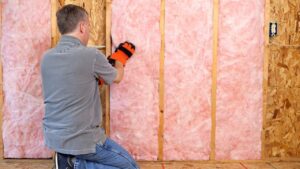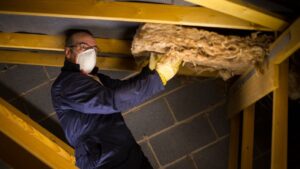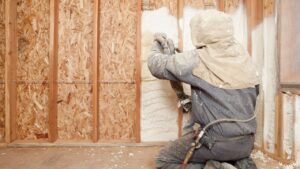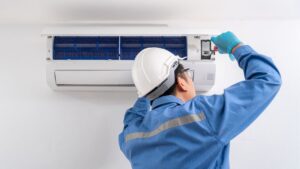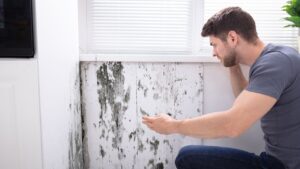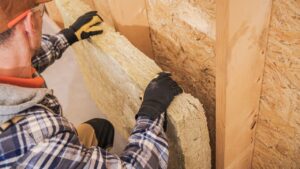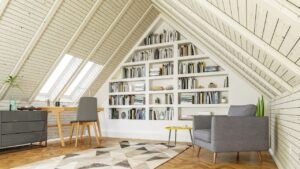Blown-in insulation sounds great for a cozy and energy-efficient home, but are there things about this kind of insulation that you aren’t finding easily online?
In this article, we talk about potential downsides that blown-in insulation might be creating in your attic or crawl spaces.
Compromised Efficiency in Uneven Spaces
Blown-in insulation is flexible but struggles with the irregular nooks and crannies found in many homes. Its weakness lies in effectively reaching all the air pockets in oddly shaped areas.
Homeowners face a dilemma in ensuring even coverage, as uneven distribution may lead to cold drafts or unintended gaps causing moisture problems.
Examining the effectiveness of blown-in insulation in these unconventional spaces requires a closer attic inspection.
Challenges of Insulating Irregularly Shaped Areas
One challenge of blown in insulation is in ensuring a tight fit in unconventional corners and angled alcoves.
It’s crucial to prevent crevices and voids that can let warmth escape on cold winter days. Success in this task is not about quantity but precision. Professionals focus on factors like the density and placement of insulation to achieve a secure seal against the elements:
– Density Optimization: Striking the right balance is essential. Overcompaction reduces efficiency, while underfilling invites moisture and air. Achieving the optimal density is key.
– Strategic Placement: Professionals strategically place insulation to address every potential air leak. This involves skillful maneuvering around pipes, electrical boxes, and irregularities in the framing to ensure a comprehensive seal.
Risks of Uneven Distribution Leading to Gaps
When relying on blown-in insulation for a snug home, the risk is clear: gaps. These unwanted spaces result from uneven distribution, opening doors to chilly winter winds and scorching summer heat, compromising the energy shield homeowners aim to establish.
Although invisible, these gaps impact more than just comfort; they contribute to higher utility bills. They not only allow outside air to seep in, disrupting temperature control, but they also create areas where moisture can accumulate.
As this moisture condenses, it becomes a breeding ground for mold or mildew, posing a threat to both the comfort and health of those living in the home. Ultimately, insulation gaps can lead to unexpected spikes in energy costs and potential structural decay.
The Possibility of Moisture and Mold Growth

When trying to keep your home warm and efficient, many people choose blown-in insulation for its easy installation and full coverage. But when moisture gets involved, a hidden problem can pop up.
Blown-in insulation can trap moisture, creating a perfect place for mold and mildew to grow without being noticed. This battle between insulation and moisture reveals a big worry in the industry – the connection between trapped moisture in a home’s walls and the serious problems that mold can cause. This can mess with the air you breathe inside and even damage the structure of your home.
How Blown-in Insulation Retains Moisture
If blown-in insulation isn’t installed properly or lacks good vapor barriers, it can soak up surrounding moisture. Materials like fiberglass or cellulose, used for their porous nature to trap heat, can also retain water. This can lead to potential problems with mold and mildew if the moisture doesn’t have a chance to dry out.
As the weather changes, temperature shifts can unknowingly cause condensation within the walls where blown-in insulation is placed.
In older homes we regularly find areas where dampness goes unnoticed, allowing mold spores to quietly multiply. Over time, this harms both the air quality inside your home and the structural strength of the insulation itself.
Allergen Accumulation and Air Quality Concerns
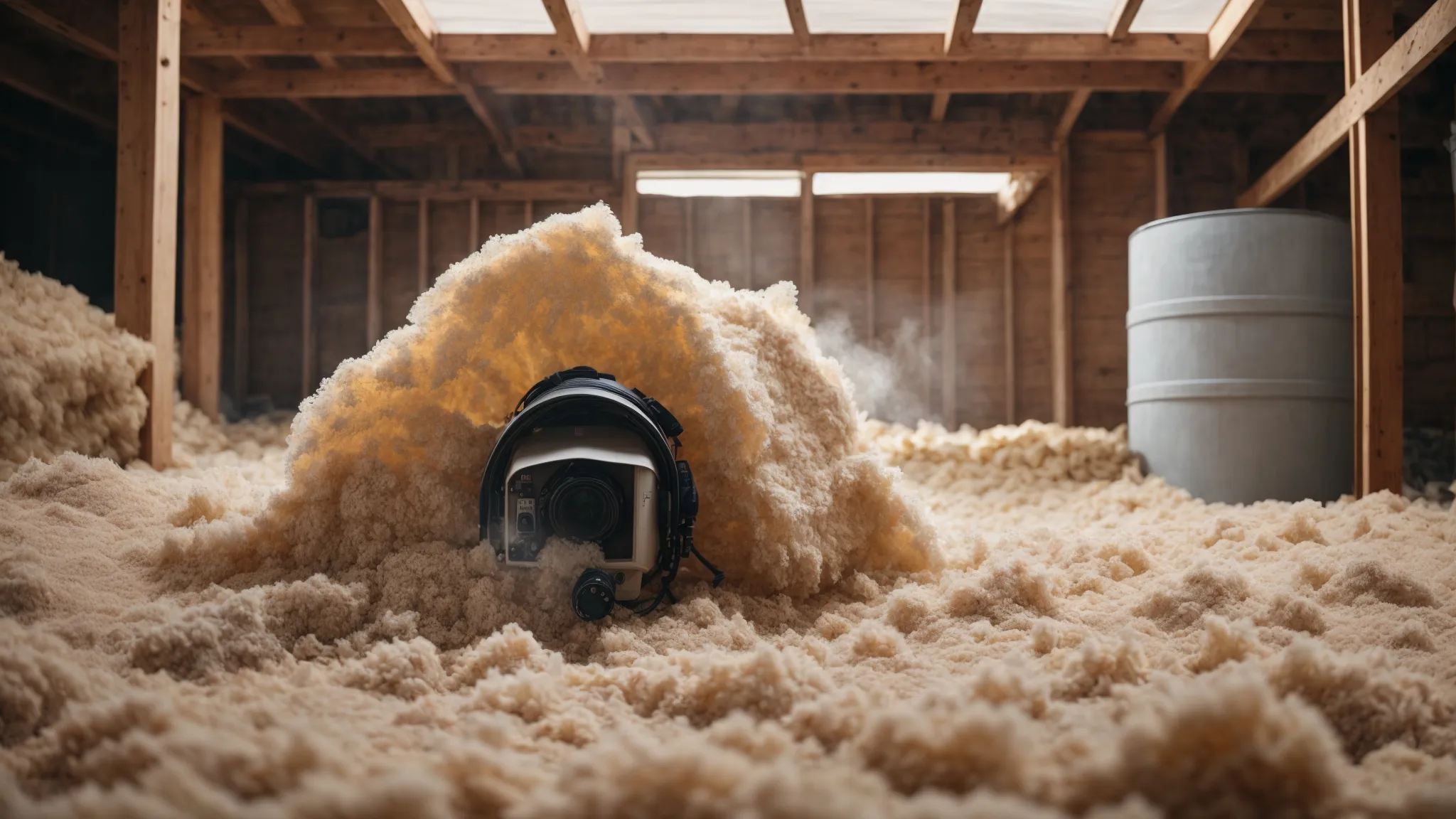
Homeowners often choose blown-in insulation for its easy installation and energy-saving benefits, but it’s crucial to acknowledge a potential issue: allergens.
Over time, tiny invaders can sneak into and settle within the insulation fibers, raising concerns for those focused on respiratory health.
The Tendency of Blown-in Insulation to Harbor Allergens
Blown-in insulation, despite its convenience, has a downside – it attracts allergens. Its fibrous structure becomes a haven for dust mites, pollen, and other irritants that can worsen allergies and respiratory problems.
This highlights the importance for homeowners to carefully consider the balance between insulation benefits and potential health risks. To maintain a home’s air quality, a thoughtful approach to insulation choices and cleanliness is necessary. Here’s a breakdown:
– Insulation Type:
– Blown-in: High allergen retention, potentially negative impact on air quality
– Foam: Low allergen retention, generally positive impact
– Fiberglass: Medium allergen retention, variable impact on air quality
Regular inspections and cleanups are crucial, especially in homes where sensitivity to allergens is a concern. Professionals with expertise can navigate these issues, ensuring that a home’s coziness doesn’t compromise the health of its occupants.
Impact on Indoor Air Quality and Respiratory Health
An increase in airborne irritants can significantly worsen allergy symptoms, trigger asthma attacks, and lead to other respiratory issues for residents.
To reduce these risks, proactive steps are vital. Regular clean-ups and replacements, complemented by professional inspections, help prevent the gradual infiltration of irritants. This approach safeguards a home’s air purity and the well-being of the lungs that rely on it.
Potential for Rodent Infestation and Damage

While blown-in insulation provides warmth, it also attracts unwelcome visitors like rodents. These creatures consider the fluffy layers of cellulose and fiberglass excellent living spaces, resulting in infestations that pose threats to both homes and health.
Taking action to address the inadvertent invitation to pests and the havoc they create within insulation is a crucial step in protecting residential sanctuaries from the silent damage caused by these intruders.
How Blown-in Insulation Can Attract Rodents
Blown-in insulation acts like a tempting call for rodents. These pests seek nesting materials, and the soft, fluffy texture of cellulose or fiberglass provides an ideal environment. Unaware homeowners might as well be inviting rodents in by offering a cozy nesting site.
Once rodents make themselves at home, the problems escalate rapidly. Their sharp teeth gnaw through the insulation, compromising the home’s insulation integrity. This opens the door to more unwelcome critters and the resulting damage. Each chew and nest burrowed into the insulation could mean potential costly repairs and health risks for the residents.
Consequences of Pest Infestations in Insulation
The consequences of a rodent takeover in a home’s insulation go beyond being a nuisance; they pose a serious safety threat. Rodents can cause substantial damage to the home’s electrical wiring, as they are notorious for chewing through cables. This creates a potential risk of fires and power outages.
| Insulation Compromise | Risk Factors | Homeowner Impact |
|---|---|---|
| Nesting and gnawing | Electrical damage, Fire hazard | Safety threats, Increased insurance premiums |
| Insulation degradation | Energy inefficiency, Pathogens | Higher utility bills, Health concerns |
Beyond the impact on wires, the consequences of rodent invasions extend to the overall insulation performance. As rodents nest and multiply, they compress and displace
the insulation material, diminishing its effectiveness. This results in increased energy costs and introduces harmful pathogens that can affect human health.
Difficulty in Detecting and Addressing Leaks

Blown-in insulation is great for keeping your home cozy and saving energy, but it has a challenge: finding and fixing leaks.
Leaks can hide for a long time in insulated spaces, making it tricky for homeowners. Detecting and fixing these leaks without causing big disruptions can be hard.
If leaks go unnoticed, they quietly make the insulation less effective, causing problems in repairs. So, it’s important to be careful when finding and fixing leaks in blown-in insulation.
Challenges in Finding Leaks Within Blown-in Insulation
Finding leaks in blown-in insulation is like looking for a needle in a haystack. This insulation covers the space, hiding signs of leaks that a stiffer material might show. Spotting these sneaky air and moisture breaches needs professional help because the usual visual clues are hidden by the qualities that make blown-in insulation work.
To uncover these hidden leaks, experts use advanced tools like infrared cameras or blower door tests. These gadgets can find temperature differences and air flows that indicate leaks, but figuring out the exact location and size of the leaks is complex. It needs an experienced person to navigate the details of a home’s insulated areas.
Complications in Repair and Replacement Due to Hidden Leaks
Fixing leaks in blown-in insulation creates challenges for homeowners. The sneaky nature of these leaks often means tearing down walls or disrupting big sections of insulation, resulting in invasive home repairs that come with a considerable cost and mess.
Even after finding leaks, replacing the compromised insulation isn’t easy. It’s crucial to match the original installation’s density and coverage to maintain the home’s energy efficiency. Professionals have to carefully ensure that the new material blends.
Shortcomings in Soundproofing Capabilities

While blown insulation is good for keeping the home warm, it might not be as effective in blocking out noise when compared to other materials.
The factors influencing its ability to control sound are complex, requiring a deeper understanding of how to make a home not just warm but also a peaceful haven away from outside noises.
Comparing the Sound Dampening Performance to Alternatives
When comparing blown-in insulation to other soundproofing options, it falls short in acoustics despite being excellent for thermal insulation.
Materials like spray foam and rigid foam boards, being denser, provide more effective sound barriers. Choosing insulation should align with the specific acoustical needs of a home.
While blown-in insulation has its advantages for thermal control, residents seeking peace and quiet may prefer robust alternatives such as spray foam or foam boards to reduce the impact of daily noise.
Factors Diminishing the Soundproofing Effectiveness of Blown-in Insulation
Several factors contribute to diminishing the soundproofing effectiveness of blown-in insulation. One primary factor is the nature of the insulation material itself. While blown-in insulation excels in thermal control, its loose and fibrous composition may not provide sufficient density to effectively block and absorb sound waves.
Additionally, settling over time can occur, leading to a decrease in overall insulation density and, consequently, a reduction in soundproofing capabilities. Gaps and irregularities in installation also play a role, allowing sound to bypass the insulation and compromise its effectiveness.
Homeowners considering soundproofing options should be mindful of these factors and may explore denser alternatives like spray foam or rigid foam boards for more robust acoustic insulation solutions.
Universal Insulation Doctor: Your solution for insulation problems!
Discover the solution with Universal Insulation Doctor! If you’re dealing with problems like uneven coverage, moisture troubles, unwelcome rodents, allergens, elusive leaks, or soundproofing challenges due to blown-in insulation, we’re here to help.
Our team specializes in fixing these issues to ensure your home stays cozy, safe, and free from hassles. Don’t let insulation problems disrupt your comfort – contact Universal Insulation Doctor, your trusted partner in creating a worry-free and comfortable living environment for you and your family!
Frequently Ask Questions
How can homeowners proactively address the downsides of blown-in insulation?
Regular inspections, proper installation, and timely maintenance are key to proactively addressing the downsides of blown-in attic insulation. Consulting with insulation professionals can help homeowners make informed decisions.
Can blown-in insulation cause health issues due to allergen accumulation?
Yes, the accumulation of allergens within blown attic insulation can trigger respiratory issues and allergies for individuals sensitive to dust mites, pollen, and other irritants.
Can blown-in insulation affect the resale value of a home?
The condition and effectiveness of blown-in insulation can impact a home's energy efficiency, potentially influencing its resale value. Addressing any issues promptly can contribute to a well-maintained property.
Are there specific steps homeowners can take to prevent rodent infestations attracted to blown-in insulation?
Implementing preventive measures like sealing entry points and conducting regular pest inspections and pest control can help deter rodents from making a home in blown-in insulation.
Can blown-in insulation be combined with other insulation types for enhanced performance?
Yes, homeowners can explore hybrid insulation solutions, combining blown-in insulation with other types to address specific concerns and achieve a balance between thermal efficiency and other factors.

